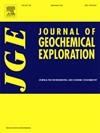半干旱至湿润亚热带城市、工矿区饮用水中重金属的赋存、分布及生态健康风险评价
IF 3.3
2区 地球科学
Q1 GEOCHEMISTRY & GEOPHYSICS
引用次数: 0
摘要
目前的研究评估了巴基斯坦半干旱至湿润亚热带地区的城市、工业和矿区通过饮用水摄入重金属所带来的生态和人类健康风险。共采集和分析了180份水样。物理参数包括pH值、电导率、硝酸盐、碳酸盐和总可溶性盐保持在允许范围内。然而,镉(Cd)、铬(Cr)、铁(Fe)、锰(Mn)、镍(Ni)、铅(Pb)和锌(Zn)的平均浓度超过了世界卫生组织(WHO)的指导方针,范围为1.45-14.5毫克、3.75-15.8毫克、11.5-44.3毫克、4.12-33.2毫克、0.95-15.8毫克、0.85-14.9毫克和0.35-10.9毫克。l - 1。污染因子(CF)分析表明,Cd污染程度最高,污染负荷指数(PLI)值为>;1在所有地点,确认严重的HM污染。此外,生态风险评估(ERA)显示与HM暴露相关的生态风险水平由低到高。儿童的HMs平均每日摄入量(ADI)明显高于成人。Cd (2.9E+ 03-1.8E +04)和Pb (1.6E+ 00-3.8E +01)的健康危害商(HQ)值及危害指数(HI)提示非致癌健康风险。此外,致癌风险(CR)超过阈值(CR >;所有地点的铅含量均为1.0E−06),而Cr和Ni在许多地点都有风险。统计分析,包括主成分分析(PCA)和pearson’s相关,显示了几个hm之间的显著相关(p<0.05)。对饮用水进行有效处理对于减轻研究区域内与HMs污染有关的健康和生态风险至关重要。本文章由计算机程序翻译,如有差异,请以英文原文为准。

Occurrence, Distribution and Ecological Health Risk Assessment of Heavy Metals Through Consumption of Drinking Water in Urban, Industrial, and Mining Areas of Semi − Arid to Humid Subtropical Areas
The current study assessed ecological and human health risks associated with heavy metals (HMs) consumption via drinking water from urban, industrial, and mining areas across semi-arid to humid subtropical areas of Pakistan. A total of 180 water samples were collected and analyzed. The physical parameters including pH, electrical conductivity, nitrates, carbonates, and total soluble salts remained within thepermissible limits. However, the average concentrations of cadmium (Cd), chromium (Cr), iron (Fe), manganese (Mn), nickel (Ni), lead (Pb), and zinc (Zn) surpassed World Health Organization (WHO) guidelines, with ranges from 1.45–14.5, 3.75–15.8, 11.5–44.3, 4.12–33.2, 0.95–15.8, 0.85–14.9, and 0.35–10.9 mg.L–1, respectively. Contamination factor (CF) analysis indicated highest pollution levels from Cd, while pollution load index (PLI) values were > 1 across all sites, confirming significant HM pollution. Further, ecological risk assessment (ERA) showed varying levels of ecological risk, from low to high, associated with HM exposure. Average daily intake (ADI) of HMs was remarkably higher in children than adults. Health hazard quotient (HQ) values for Cd (2.9E+03–1.8E+04) and Pb (1.6E+00–3.8E+01), along with hazard indices (HI), indicated non-carcinogenic health risks. Moreover, carcinogenic risk (CR) exceeded threshold (CR > 1.0E−06) for Pb at all sites, with Cr and Ni posing risks at numerous sites. Statistical analyses, including principal component analysis (PCA) and pearson’s correlation, revealed significant correlations (p<0.05) among several HMs. Effective treatment of drinking water is essential to mitigate the health and ecological risks associated with HMs contamination in the study area.
求助全文
通过发布文献求助,成功后即可免费获取论文全文。
去求助
来源期刊

Journal of Geochemical Exploration
地学-地球化学与地球物理
CiteScore
7.40
自引率
7.70%
发文量
148
审稿时长
8.1 months
期刊介绍:
Journal of Geochemical Exploration is mostly dedicated to publication of original studies in exploration and environmental geochemistry and related topics.
Contributions considered of prevalent interest for the journal include researches based on the application of innovative methods to:
define the genesis and the evolution of mineral deposits including transfer of elements in large-scale mineralized areas.
analyze complex systems at the boundaries between bio-geochemistry, metal transport and mineral accumulation.
evaluate effects of historical mining activities on the surface environment.
trace pollutant sources and define their fate and transport models in the near-surface and surface environments involving solid, fluid and aerial matrices.
assess and quantify natural and technogenic radioactivity in the environment.
determine geochemical anomalies and set baseline reference values using compositional data analysis, multivariate statistics and geo-spatial analysis.
assess the impacts of anthropogenic contamination on ecosystems and human health at local and regional scale to prioritize and classify risks through deterministic and stochastic approaches.
Papers dedicated to the presentation of newly developed methods in analytical geochemistry to be applied in the field or in laboratory are also within the topics of interest for the journal.
 求助内容:
求助内容: 应助结果提醒方式:
应助结果提醒方式:


